- Details
- Hits: 939
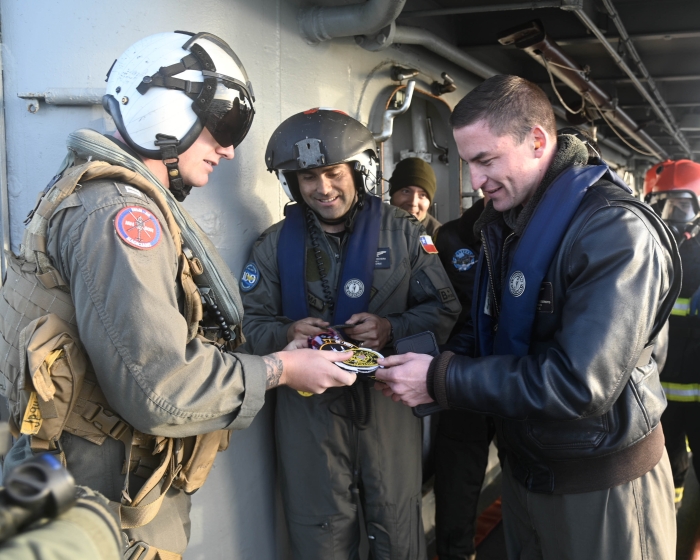
Pacific Ocean. (October 29, 2023): Ask any veteran and they will say the friends they made while serving in the military have lasted a lifetime. In this photo by MC1 Steven Khor, a U.S. Navy helicopter pilot, left, assigned to the "Scorpions" of Helicopter Maritime Strike Squadron 49 exchanges patches with a Chilean navy helicopter pilot after landing on the flight deck of the Chilean navy ship CNS Almirante Williams.
These veteran pilots are participating in the at-sea phase of Teamwork South 2023, a biennial U.S. and Chilean naval exercise that conducts training scenarios in anti-surface and submarine warfare. Established in 1995, the Teamwork South exercises are designed to strengthen the bonds of friendship and cooperation between both Navies.
The Chilean Navy is 25,000 strong including over 5,000 Marines and a fleet of hundreds of transport and combatant ships. The Chilean’s also operate four submarines with tender ships to support them. In addition to its military prowess, Chile’s armed forces provides social assistance and health care to the civilian population, especially in times of natural catastrophe. This year, U.S. and Chilean pilots got the chance to practice realistic scenarios of surface and anti-submarine warfare while establishing closer coordination in tempo and tactics.
- Details
- Hits: 1077
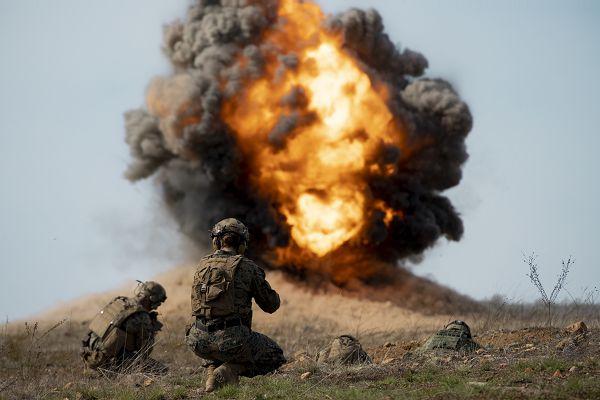
Camp Pendleton, California. (October 26, 2023): They came from the other side of the world to train with America’s best. The 1st Guards Battalion, 7th Singapore Infantry Brigade, Singapore Armed Forces joined the I Marine Expeditionary Force during Valiant Mark 2023 exercises held here. In this photo by Sergeant Nicolas Atehortua, U.S. Marine Corps Staff Sergeant Dana Beesley, center, a communication operations chief, takes cover with members of the Singapore armed forces after a controlled explosion. The Singapore troops worked alongside the 2nd Battalion, 4th Marines and the 13th Marine Expeditionary Unit during the weeklong event.
The exercise gave members of the Singapore military the chance to get to know their Marine counterparts and to take part in realistic combat training and subject matter exchanges. The two militaries compared notes on snipers, mortars, indirect fires, and fire support coordination. Other topics included the use of combat engineers, anti-tank strategy, unmanned aerial systems, and field medicine. Singapore Guardsmen and Marines fought their way through obstacles during live fire exercises that improved their small-arms tactics. These exchanges included how to integrate mortars, artillery, and naval gunfire to provide close air support.
The highlight of the training was an amphibious assault exercise where U.S. Marines and Singapore Guardsmen seized two inland objectives with two reinforced companies from 2nd Battalion, 4th Marines and one company from 1st Guards Battalion. After much planning, the militaries demonstrated their combined arms and amphibious warfighting skills.
- Details
- Hits: 926
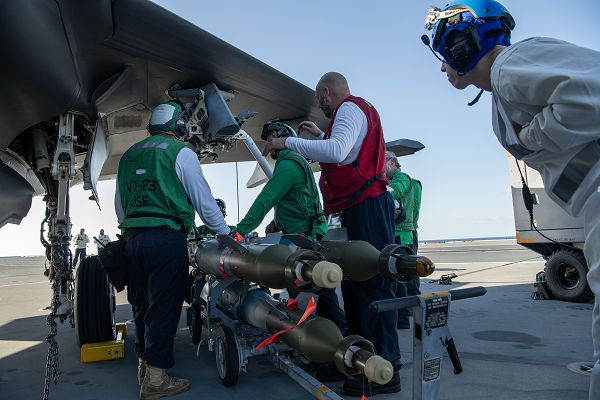
Atlantic Ocean. (October 29, 2023): In this photo Kyra Helwick, Sailors from Air Test and Evaluation Squadron 23 and British Navy sailors load ordnance onto a F-35B Lightning II during flight training aboard the Royal Navy aircraft carrier HMS Prince of Wales.
The squadron is collaborating with British sailors conducting flight trials of the F-35B Stealth, a short take-off, vertical landing version of the multirole fighter. The test squadron consists of forty officers and ninety enlisted drawn from the Navy and Marines along with 340 civilian contractors. Their mission is to evaluate fixed wing tactical aircraft and all manner of new Unmanned Aerial Vehicles. The Squadron provides aircraft, pilots, and maintenance services to do these evaluations anywhere in the world.
The Prince of Wales, unlike most carriers, is not fitted with catapults to launch its aircraft and is instead designed to field the fifth-generation short take-off/runway version of the stealthy F35B. This single-seat, single-engine, all-weather fighter is used for both air superiority and strike missions. The Prince of Wales also deploys Merlin helicopters for airborne early warning and anti-submarine warfare. Currently there are fourteen aircraft carriers that operate these vertical take-off aircraft including the United States, the United Kingdom, Italy, and Spain.
- Details
- Hits: 848
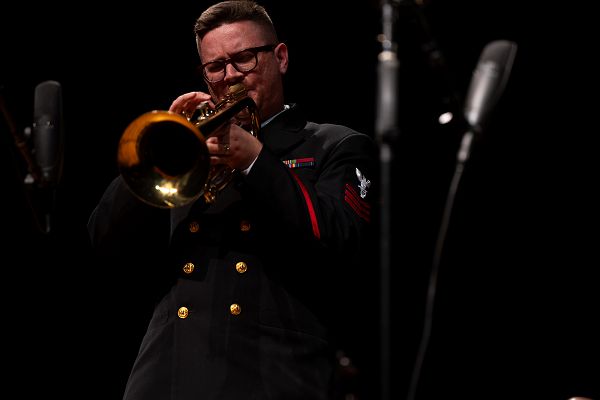
Cumming, Georgia. (October 29, 2023): Since the founding of the Republic, music has played a vital role in both training troops and inspiring fellow Americans to join the fight. In this photo by Musician 1st Class Matthew Gagliardo, Navy Musician 1st Class David Kapral performs on the bass trumpet at West Forsyth High School during the Commodores 2023 National Tour.
The Commodores is a collection of tours held each year by various units of the Navy Band. For musicians like these, this means weeks on the road doing performances for audiences as small as local high schools. They also perform at major municipal halls, community centers, and countless universities and outdoor venues such as football stadiums and on the Capitol Mall.
The history of martial tunes begins with the Medieval Turks who are credited with developing the first truly military bands. These “Mehtaran,” or "pre-eminences", played during the military campaigns of the Ottoman Turks who ruled Europe and Asia for over six hundred years. The Ottomans were the first to use band instruments, such as fife, drum, and bugle, to communicate orders to soldiers in battle.
The Americans continued this tradition during the Civil War where each regiment was required to organize a field band to help command and control tactical units by dictating movements through specific tunes. Much later, General George Armstrong Custer required the Seventh Cavalry Band to play during actual combat operations to inspire his troopers, although to an unfortunate outcome.
- Details
- Hits: 829
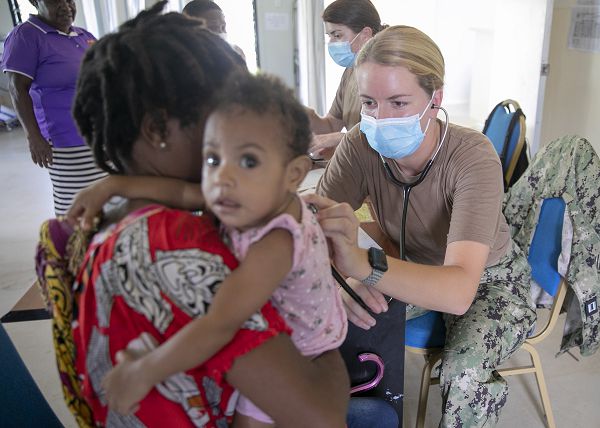
Wewak, Papua New Guinea (October 22, 2023): It is one of the bright spots of Navy service, using your training and lifesaving skills to help those less fortunate. In this photo by MC1 Kegan E. Kay, Navy Lieutenant Anna Rayne conducts a wellness check on a young Papua New Guinean patient during Pacific Partnership 2023, the largest humanitarian mission in the Indo-Pacific. Lt. Rayne and her colleagues are visiting Papua New Guinea as part of an annual multinational humanitarian assistance and disaster relief preparedness program.
The Pacific Partnership series was created after the 2004 Indian Ocean earthquake and tsunami that killed over 230,000 people. To improve coordination between non-profit relief agencies, local governments, and regional military forces in the future, Pacific Partnership strengthens relationships and security ties to be better prepared. Each year, the U.S. Navy sends medical teams and civil affairs units throughout the Indo-Pacific to work with local military and civilian relief agencies to ensure the smooth delivery of goods and services.
- Details
- Hits: 996
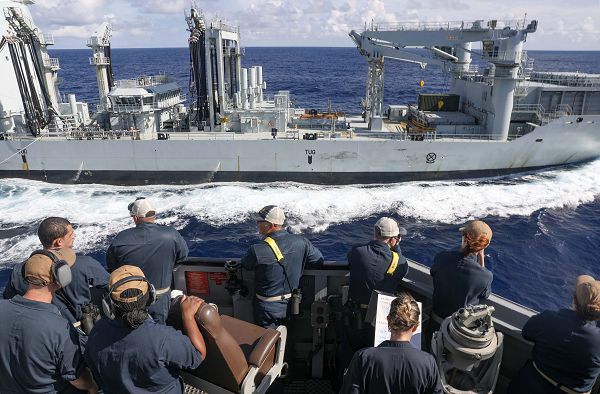
South China Sea. (October 28, 2023): Anyone who has ever tried to pull their fishing boat alongside a buddy will testify to how difficult such a seemingly easy task can be. Can you imagine two giant ships, jockeying into position in harsh weather, trying to offload tons of fuel? In this photo by MC1 Greg Johnson, Royal Canadian Navy supply ship MV Asterix transfers supplies to the Arleigh Burke-class guided-missile destroyer USS Dewey while underway in the South China Sea.
In early naval history, the world’s oceans were dotted with “coaling” stations that serviced the world’s fleets with fuel, food, and water which allowed nations to project their power. These stations, however, were vulnerable to disruption or attack thus cutting off a vital lifeline to ships in time of war. The solution was to design a system to transfer highly flammable fuels and other supplies “ship to ship” while underway.


